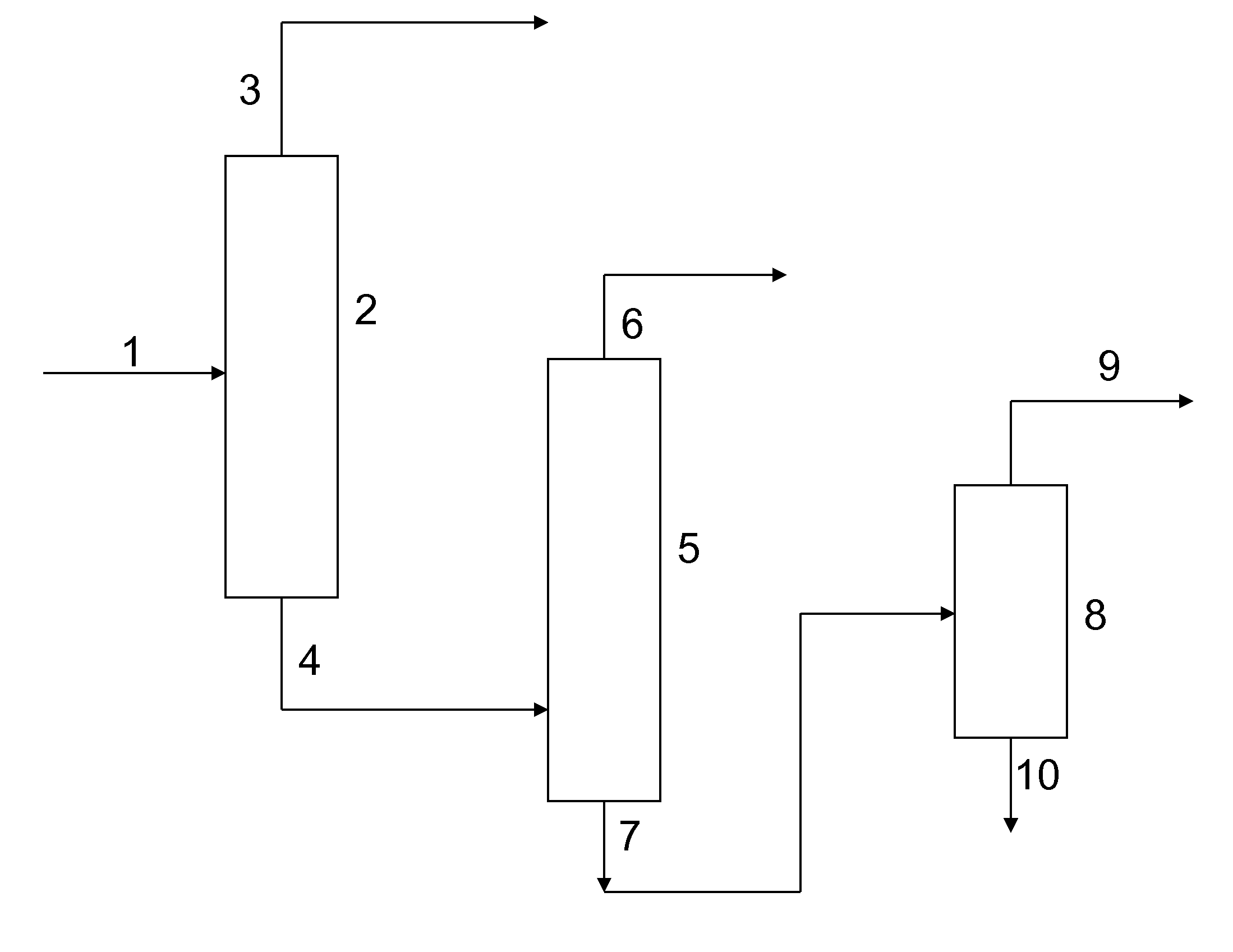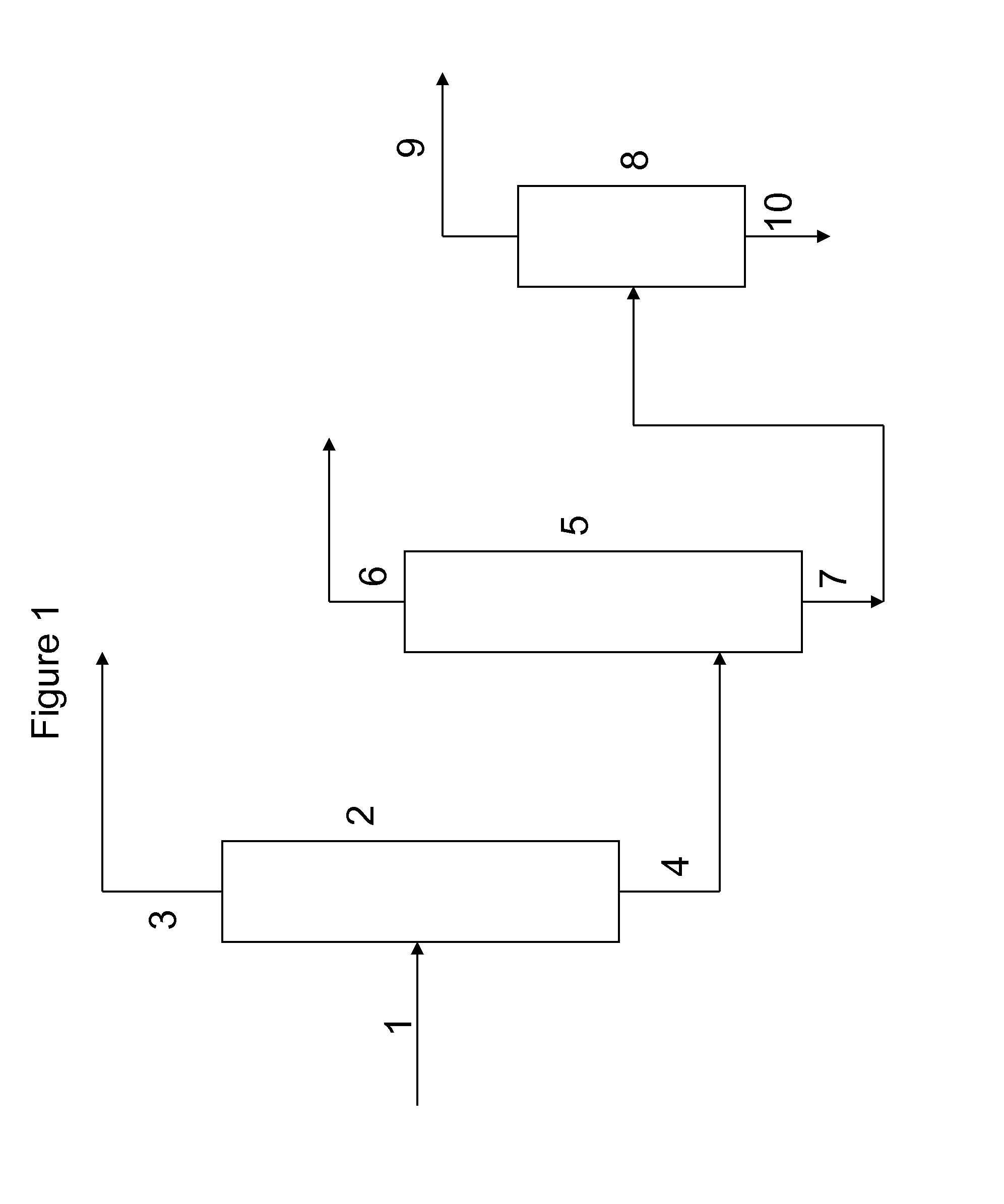Method for Recovering Di-Trimethylolpropane and Trimethylolpropane-Enriched Product Streams From the Side Streams of Trimethylolpropane Production
- Summary
- Abstract
- Description
- Claims
- Application Information
AI Technical Summary
Benefits of technology
Problems solved by technology
Method used
Image
Examples
example 1
[0064]For the inventive workup of the high-boiling fractions and residues from the distillative purification of trimethylolpropane, a mixture was used which had the following composition determined by gas chromatography (%):
First runnings0.9Monocyclic formal (I)0.1Trimethylolpropane20.8Intermediate fraction I3.3Ditrimethylolpropane20.2Intermediate fraction II17.8Linear bistrimethylolpropane30.9formal (II)High boilers6.0
[0065]Water at 60° C. was added to the organic residue to produce a homogeneous aqueous solution with a content of 60% by weight of dissolved organic residue. To 100 parts by weight of aqueous solution were added 5 parts by weight of a commercial ruthenium-on-activated carbon catalyst in powder form with a metal loading of 5% by weight, and 1.8 parts by weight of concentrated sulphuric acid (98%). The resulting suspension was subsequently treated with hydrogen in a 1 litre autoclave under the following conditions:
TABLE 1Hydrogenation of an aqueous solution of residues...
example 2
[0066]For the inventive workup of the high-boiling fractions and residues from the distillative purification of trimethylolpropane, a mixture was used which had the following composition determined by gas chromatography (%):
First runnings0Monocyclic formal (I)0Trimethylolpropane7.0Intermediate fraction I19.8Ditrimethylolpropane20.3Intermediate fraction II0.1Linear bistrimethylolpropane47.0formal (II)High boilers5.8
[0067]Water at 60° C. was added to the organic residue to produce a homogeneous aqueous solution with a content of 60% by weight of dissolved organic residue. To 100 parts by weight of aqueous solution were added 0.5 part by weight of a commercial ruthenium-on-activated carbon catalyst in powder form with a metal loading of 5% by weight, and 0.5 part by weight of an acidic commercial Y-type zeolite. The resulting suspension was subsequently treated with hydrogen in a 1 litre autoclave under the following conditions:
TABLE 2Hydrogenation of an aqueous solution of residues fr...
example 3
[0068]For the distillative workup of the hydrogenated material obtained after filtration of the catalyst and of the acidic zeolite according to Example 2, an aqueous solution which contained 40% by weight of water and 60% by weight of organic components was used, and the organic component had the following composition determined by gas chromatography (%):
First runnings6.3Monocyclic formal (I)0.3Trimethylolpropane64.4Intermediate fraction I0.6Ditrimethylolpropane28.0Intermediate fraction II0.1Linear bistrimethylolpropane0.1formal (II)High boilers0.2
Example 3a (1)
Removal of Water and First Runnings
[0069]In a first distillation, in a 20-tray column with reboiler, at a bottom temperature of 96° C. and a pressure of 73 hPa, water and low boilers were removed as distillate. The resulting distillation bottoms contained about 800 ppm by weight of water and had the following composition determined by gas chromatography (%):
First runnings0.6Monocyclic formal (I)0.1Trimethylolpropane72.0Interm...
PUM
| Property | Measurement | Unit |
|---|---|---|
| Temperature | aaaaa | aaaaa |
| Temperature | aaaaa | aaaaa |
| Temperature | aaaaa | aaaaa |
Abstract
Description
Claims
Application Information
 Login to View More
Login to View More - R&D
- Intellectual Property
- Life Sciences
- Materials
- Tech Scout
- Unparalleled Data Quality
- Higher Quality Content
- 60% Fewer Hallucinations
Browse by: Latest US Patents, China's latest patents, Technical Efficacy Thesaurus, Application Domain, Technology Topic, Popular Technical Reports.
© 2025 PatSnap. All rights reserved.Legal|Privacy policy|Modern Slavery Act Transparency Statement|Sitemap|About US| Contact US: help@patsnap.com



